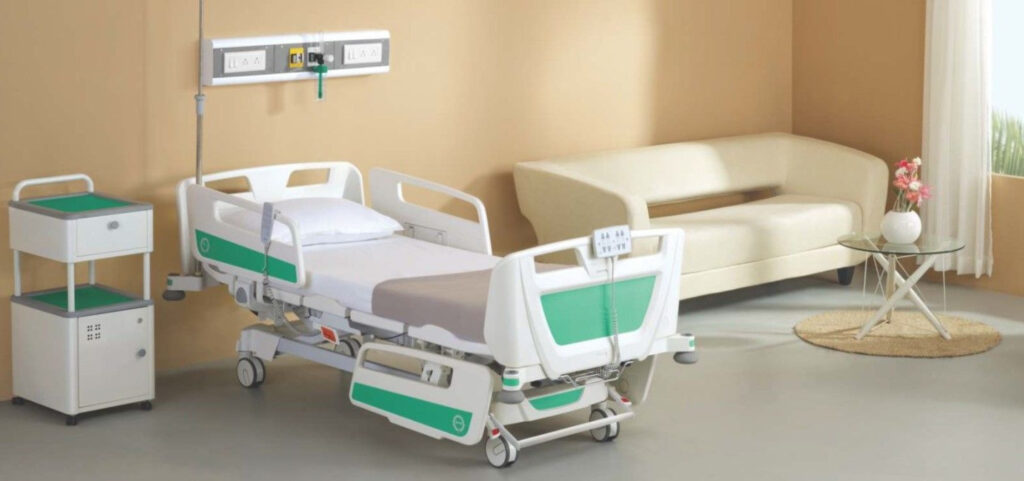
- Blogs
Top Trends in Hospital Furniture Design
- July 15, 2024
- By admin
Not only does the overall efficiency of the healthcare facility but also the standard of care delivered to the patients is highly dependent on the furniture in hospitals. With time, the design and functionality of furniture in hospitals have changed. Here are some top trends in hospital furniture design, bringing advanced comfort to the patients, improving functionality, and optimizing healthcare environments.
1. Ergonomics and Comfort:
Ergonomics is one of the critical features in the design of modern hospital furniture. It is ergonomically conceptualized to make both the patient and health provider move and rest in natural postures that curtail strain and promote comfort. Adjustable beds, chairs designed to support the back at the middle, and ergonomic workstations for staff will assist with providing a more comfortable and efficient setting.
2. Infection Control and Hygiene:
Infection control is an important feature in a hospital. The prevention of infection through the design of furniture and other equipment at a healthcare facility is therefore given wide prominence. Easy-to-clean surfaces, antimicrobial surfaces, and seamless designs with as few crevices as possible to capture dirt and bacteria become customary. Furniture withstood frequent cleaning and disinfections, all to retain the sterile environment.
3. Sustainability and Eco-Friendly Materials:
Sustainability in furnishings has become important to all industries, not just healthcare. Furniture developed for hospitals includes eco-friendly materials and sustainable manufacturing. This increasingly represents a commitment to the environment because of the use of recyclable materials, finishes that are low in VOCs, and energy-efficient production techniques.
4. Modularity and Flexibility:
Most hospital furniture used nowadays is modular and flexible, making them easy to be moved about for a different number of purposes. A concept such as modular designs offers facilities flexibility in reaction to varying patient loads, kinds of treatments, and space demands. Furnishings that can easily be relocated, stacked, or re-arranged add to the versatility of healthcare spaces.
5. Technology Integration:
Most recently, technology has also taken a front seat in healthcare furniture designs in this digital age. Aspects encompass inventions of beds and chairs with in-built charging ports, workstations with adjustable monitor arms, and furniture that contains cable management systems for products whose operation involves multiple cables. Technology integration improves efficiency and convenience for both the patients and healthcare providers.
6. Patient-Centered Design:
This style is patient-centered in design and focuses on the patient to create an environment that helps promote the best patient experience. Furnishings are comfortable, attractive, and facilitate horizontal positioning to promote rest and recuperation. Reclining chairs for visitors, variable lighting, and multiple storage options all help create a more homelike feeling in a space to support patient comfort.
7. Multiple Uses:
And more so, the modern hospital furniture tends to fit into multi-functional space and utilities. For example, overbed tables that double up as workstations, chairs that can convert to beds for visitors, storage units that double up as seats, etc. The multi-functional furniture enhances the optimization of space allowing for greater flexibility in healthcare settings.
8. Color and Design Aesthetics:
Gone are those days of sterile, institutional-looking hospital environments. The furniture design in hospitals today is based on the very idea of embracing color and aesthetics to make it warm, welcoming, and soothing to the patients. Color schemes are chosen that will go on to convey subtle feelings of tranquility and comfort, while contemporary designs contribute to creating a better experience in treatment settings. Natural materials and textures also blend in to give this environment an inviting appearance.
Conclusion:
The key trends in the design of furniture for hospitals seek improvements in patient care, functionality, adaptability, and sustainability of the healthcare environment. Some of the trends in hospital furniture designing relate to ergonomics, infection control, sustainability, modularity, technology integration, patient-centered design, multi-functionality, and aesthetics through design. This would help healthcare facilities be at par with the best in both patients and staff, if equipped with proper knowledge regarding these trends.
Looking to upgrade your hospital furniture? Contact us today to explore our range of innovative and high-quality hospital furniture solutions. As a leading medical equipment supplier in Dubai, we offer expert advice and comprehensive products to meet your healthcare facility’s needs.
Related Posts
Explore Our Range
Visit our website to discover our full range of medical equipment in Dubai and see how Regal Medical Equipments Trading LLC can support your healthcare practice. Whether you’re upgrading your current equipment or need specialized tools, we offer exceptional products and unparalleled customer service to meet your specific needs.





